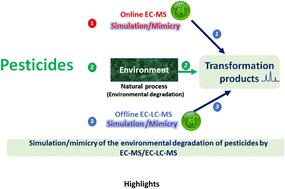当前位置:
X-MOL 学术
›
Environ. Sci.: Processes Impacts
›
论文详情
Our official English website, www.x-mol.net, welcomes your
feedback! (Note: you will need to create a separate account there.)
Electrochemistry coupled with mass spectrometry for the prediction of the environmental fate and elucidation of the degradation mechanisms of pesticides: current status and future prospects
Environmental Science: Processes & Impacts ( IF 4.3 ) Pub Date : 2023-01-12 , DOI: 10.1039/d2em00451h Ranil Clément Tonleu Temgoua 1, 2, 3 , Ignas Kenfack Tonlé 3 , Mohammed Boujtita 1
Environmental Science: Processes & Impacts ( IF 4.3 ) Pub Date : 2023-01-12 , DOI: 10.1039/d2em00451h Ranil Clément Tonleu Temgoua 1, 2, 3 , Ignas Kenfack Tonlé 3 , Mohammed Boujtita 1
Affiliation

|
One of the crucial steps in the development of a new pesticide (active molecule) is predicting its environmental and in vivo fate, so as to determine potential consequences to a living organism's health and ecology as a whole. In this regard, pesticides undergo transformation processes in response to biotic and abiotic stress. Therefore, there is a need to investigate pesticide transformation products (TPs) and the formation processes they could undergo during the manufacturing process and when discharged into the ecosystem. Although methods based on biological in vitro and in vivo experimental models are tools of choice for the elucidation of metabolic pathways of pesticides (xenobiotics in general), electrochemistry-based techniques offer numerous advantages such as rapid and low-cost analysis, easy implementation, low sample volume requirement, no matrix effects, and miniaturization to improve the performance of the developed methods. However, for greater efficiency, electrochemistry (EC) should be coupled with analytical techniques such as mass spectrometry (MS) and sometimes liquid chromatography (LC), leading to the so-called EC-MS and EC-LC-MS hybrid techniques. In this review, past studies, current applications and utilization of EC-MS and EC-LC-MS techniques for the simulation of environmental fate/degradation of pesticides were reviewed by selected studies with chemical transformation, structures of metabolites, and some experimental conditions. The current challenges and future trends for the mimicry and prediction of the environmental fate/degradation of pesticides based on electrochemical methods combined with mass spectrometry were highlighted.
中文翻译:

电化学结合质谱法预测环境归宿和阐明农药的降解机制:现状和未来前景
开发新型杀虫剂(活性分子)的关键步骤之一是预测其环境和体内归宿,以确定对生物体健康和生态整体的潜在影响。在这方面,农药会经历转化过程以应对生物和非生物胁迫。因此,有必要研究农药转化产物 (TP) 及其在制造过程中和排放到生态系统时可能经历的形成过程。虽然基于生物体外和体内的方法实验模型是阐明杀虫剂(一般为外来物)代谢途径的首选工具,基于电化学的技术具有众多优势,例如快速和低成本分析、易于实施、样品体积要求低、无基质效应和小型化提高所开发方法的性能。然而,为了提高效率,电化学 (EC) 应与分析技术如质谱 (MS) 和液相色谱 (LC) 相结合,从而产生所谓的 EC-MS 和 EC-LC-MS 混合技术。在这篇综述中,通过选定的化学转化、代谢物结构、和一些实验条件。强调了基于电化学方法结合质谱法模拟和预测农药环境归宿/降解的当前挑战和未来趋势。
更新日期:2023-01-12
中文翻译:

电化学结合质谱法预测环境归宿和阐明农药的降解机制:现状和未来前景
开发新型杀虫剂(活性分子)的关键步骤之一是预测其环境和体内归宿,以确定对生物体健康和生态整体的潜在影响。在这方面,农药会经历转化过程以应对生物和非生物胁迫。因此,有必要研究农药转化产物 (TP) 及其在制造过程中和排放到生态系统时可能经历的形成过程。虽然基于生物体外和体内的方法实验模型是阐明杀虫剂(一般为外来物)代谢途径的首选工具,基于电化学的技术具有众多优势,例如快速和低成本分析、易于实施、样品体积要求低、无基质效应和小型化提高所开发方法的性能。然而,为了提高效率,电化学 (EC) 应与分析技术如质谱 (MS) 和液相色谱 (LC) 相结合,从而产生所谓的 EC-MS 和 EC-LC-MS 混合技术。在这篇综述中,通过选定的化学转化、代谢物结构、和一些实验条件。强调了基于电化学方法结合质谱法模拟和预测农药环境归宿/降解的当前挑战和未来趋势。











































 京公网安备 11010802027423号
京公网安备 11010802027423号